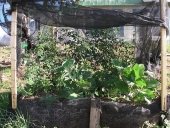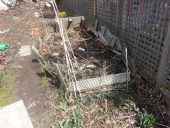I get plenty of rain, but I'm putting up a new polytunnel soon and am thinking about making a wicking bed. I want to try and make it using materials I have to hand, but also want it to function well. I'd rather not have to rebuild it with new soil every year! I'd also rather do without plastic in my beds. I just don't like mixing them with soil, although I do have woven plastic weed membrane spare if that really is the best option. The polytunnel will be set into the hillside, so I'm hoping to use the rock as one side of the bed and capture the water off the plastic roof to irrigate the bed.
So this is the concept:

I have several large polythene containers that supplied eco-cleaning products (laundry liquid/washing up liquid) that I was thinking of cutting down to form the water reservoir. These would be linked together - probably with syphon tubing over the top if I can't find adaptors to fit the existing fill/air holes. These would be filled automatically when it rained from a water barrel, that fills from the gutter and overflows first into the wicking bed and then if necessary to a leaky pipe on the rest of the polytunnel beds. If I need to provide more water in dry times (at the moment I wish) then I can top up into this barrel. The beds would have an overflow at the far end which also would irrigate the rest of the polytunnel.
To avoid the plastic membrane, keep the soil out of the water, and provide a wick, I'm proposing to use sheeps' fleece. There is plenty in my area that is just a waste product and I have already put the word out that I would like some this year. I do have a little from my 'uses for dag end fleeces' project, but I think I will need more. This would be used to line the buckets. They could then be filled inside with broken rock as a support and the fleece turned over the top and tucked around the edges - topping up if neccessary.
On top of this to grow in, I would put topsoil - probably mixed with some bought compost to give it a good start. I'm thinking I could put a thin layer of sand (we have some dirty building sand spare) between the fleece and soil to make a boundary. The front of the bed would be corrugated galvanised steel - I have lots of sheets left from the roof of an old Byre. I will need to construct a wooden support frame outside that.
I know you need a thick mulch on top of the soil . Not sure what will come to hand here, but I don't suppose it matters too much - a thick organic layer of straw and big leaves. A mulch used to develop in my old polytunnel from chop and drop, and crop debris pretty quickly. I'm wondering whether pushing kitchen vegetable scraps underneath this layer would be too much of a good thing? I struggle with m worm bin - it is just too small for my waste stream, and I am worried the worms will get neglected.
Anyway, that is most of my thoughts on the subject. Sorry for the essay, but this is something I have no experience on, so I'd like to find out if there are pitfalls I have missed. Thank you!









